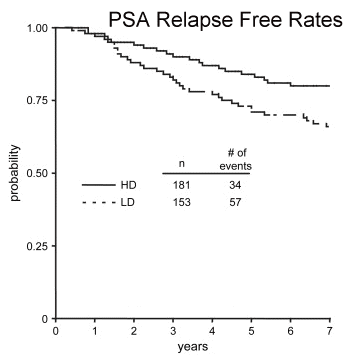|
||
|
The two groups were comparable except for a significant difference in terms of median follow-up (10 vs. 7 years, respectively) owing to the gradual increase of EART doses over time. Nevertheless, median time to prostate-specific antigen (PSA) failure was almost identical, 38 and 36 months, respectively. At univariate analysis, both 5-year biochemical relapse-free survival (bRFS) and disease-free survival (DFS) were significantly higher (83% vs. 71%] and 94% vs. 88%], respectively) in the HD group. Multivariate analysis confirmed EART dose ≥70 Gy to be independently related to both bRFS (hazard ratio 2.5, p = 0.04) and DFS (hazard ratio 3.6, p = 0.004). Similar results were obtained after the exclusion of patients receiving any androgen deprivation. After grouping the hormone-na´ve patients by postoperative PSA level the statistically significant impact of high-dose EART on both 5-year bRFS and DFS was maintained only for those with undetectable values, possibly owing to micrometastatic disease outside the irradiated area in case of detectable postoperative PSA values. ConclusionThis series provides strong support for the use of EART doses ≥70 Gy after radical retropubic prostatectomy in hrCaP patients with undetectable postoperative PSA levels. |
